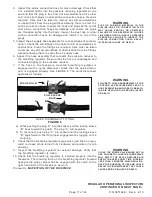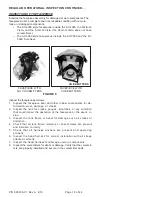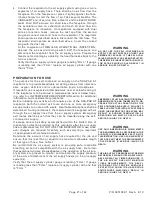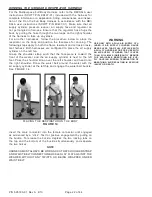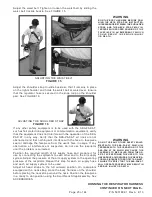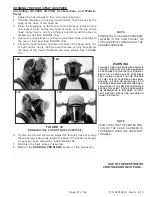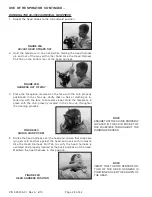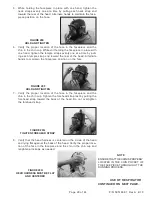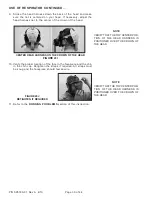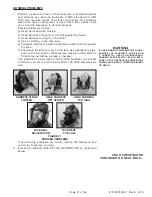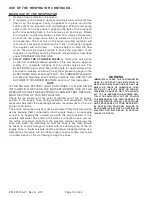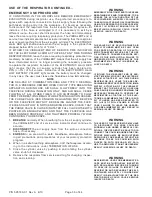
Page 21 of 44
P/N 595189-01 Rev A 4/10
WArning
do noT uSe The Self-conTAined Air
SuPPly for Any PurPoSe oTher ThAn
emergency eScAPe. if The Self-con-
TAined Air SuPPly hAS been dePleTed,
There mAy be inSufficienT Air SuPPly
for eScAPe Which could reSulT in
SeriouS inJury or deATh.
4. Connect the respirator to the air supply system using one or more
segments of air supply hose. There shall be no air flow from the
facepiece. Don the facepiece or place it tightly against the face.
Inhale sharply to start the flow of air. Take several breaths. The
VIBRALERT end of service time indicator and the ELECTRONIC
alarm shall NOT actuate. Air shall leave the facepiece through
the exhalation valve on exhalation and fresh air shall flow into
the facepiece on inhalation. On respirators equipped with dual
airline connection hoses, remove the dust cap from the second
plug and connect a second hose to the respirator. The respirator
shall operate as described above. Disconnect the first hose. The
respirator shall operate as described above. Cover the unused
plug with the dust cap.
At the completion of REGULAR OPERATIONAL INSPECTION,
depress the air-saver/donning switch, doff the facepiece and
disconnect the respirator from the air supply source. Prepare the
facepiece for donning by adjusting the head harness straps to the
full out position.
Verify that the air supply cylinder gauge is reading "FULL." If gauge
is reading less than "FULL" replace air supply cylinder with one
that is "FULL."
WArning
emergency SiTuATionS Tend To increASe
breAThing rATe And, Therefore, To de-
creASe The AcTuAl durATion of The
Self-conTAined Air SuPPly. fAilure To
TAKe Such fAcTorS inTo AccounT When
uSing The reSPirATor for eScAPe mAy
reSulT in Sudden TerminATion of
breAThing Air Which could cAuSe
SeriouS inJury or deATh.
WArning
The Air SuPPly PreSSure muST remAin
beTWeen 80 PSig And 115 PSig WiTh SuiT-
Able floW AT All TimeS during uSe. if
The Air SuPPly doeS noT mAinTAin
T h e S e r e Q u i r e m e n T S , T h e r e S P i -
rATor mAy noT Provide AdeQuATe
ProTecTion from The hAZArdouS
ATmoSPhere Which mAy reSulT in
SeriouS inJury or deATh.
WArning
uSe only breAThing Air Which meeTS
The reQuiremenTS AS deScribed in The
Air SuPPly reQuiremenTS SecTion of
ThiS inSTrucTion. uSe of An Air SuPPly
ThAT doeS noT meeT The reQuiremenTS
could reSulT in SeriouS inJury or
deATh.
PrePArATion for uSe
The purpose for the self-contained air supply on the SKA-PAK AT
respirator is to provide breathable air during escape from objection-
able, oxygen deficient and/or unbreathable (toxic) atmospheres.
If respirator use is expected at temperatures near or below freezing or
if the respirator is to be stored in temperatures near or below freez-
ing, refer to LOW TEMPERATURE OPERATION section for additional
information and supplemental procedures.
Before initiating any activity which requires use of the SKA-PAK AT
respirator, both the normal exit route and one or more emergency
escape routes to an area with a safe, breathable atmosphere shall be
determined. During normal exit, the respirator will be supplied with air
through the air supply hose from the air supply system. Emergency
exit routes shall be such that they can be travelled using the self-
contained air supply.
If escape cannot be safely accomplished within the limited time of
respiratory protection provided by this respirator after the air supply
hose is disconnected, DO NOT USE THIS RESPIRATOR; make what-
ever changes are required for safety, such as selecting a respirator
of appropriate self-contained duration.
Determine the amount of air supply hose required for the job and
ensure that it is less than or equal to the maximum allowable length
of that type of hose. See Table 1.
Be certain that the air supply system is providing safe, respirable
breathing air and is compatible with the air supply hose. Be certain
that personnel who are knowledgeable in the operation of the air sup-
ply system are present to monitor and maintain the supply pressure
at the point of attachment of the air supply hose(s) to the air supply
system(s).
Verify that the air supply cylinder gauge is reading "FULL." If gauge
is reading less than "FULL" replace air supply cylinder with one that
is "FULL."











